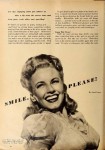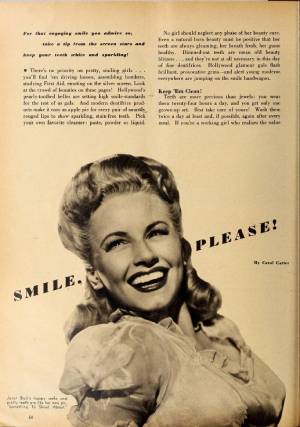
 “Smile please”, Revue Modern Screen, avril 1943, p.54
“Smile please”, Revue Modern Screen, avril 1943, p.54
Until the beginning of the 20th century, the closed mouth smile was the norm in France. In fact, emotional control was recommended by the treaties of civility and revealing one’s teeth was excluded by popular etiquette. Self-control was characteristic of the upper classes, while laughter and emotional display were associated with the working classes. The smile is also gendered since women smile more than men do and with greater amplitude.
Before the appearance of the Hollywood smile, there was a first and brief revolution of the smile in France during the Enlightenment, which coincided with the rise of French dentistry. Indeed, modern dentistry was born in France, it is the first country to recognize dentistry as an autonomous specialty with the Royal Edict of 1699. The 18th century is widely considered as the golden century of French dentistry, which spread throughout Europe with pioneering dentists such as Pierre Fauchard. The history of dental ceramics also began in France with Alexis Duchateau, who designed porcelain prostheses which were then perfected by the Parisian dentist Nicolas Dubois de Chémant. These porcelain teeth were very popular with the aristocracy on both sides of the Channel.
The rise of French dentistry and the development of a culture of sensitivity, where laughing, crying and expressing emotions became publicly acceptable among the elite, gave the smile its first visibility. The Parisian smile of the Age of Enlightenment was thus the ancestor of the Hollywood smile. Vigée le Brun's self-portrait in 1787 marked the apotheosis of this new smile. The abolition of guilds, with the Le Chapelier law of 1791 and the suppression of universities in 1792, led to the decline of French dentistry and with it, that of the smile except in the Parisian party and libertine circles of the end of the 19th century.
The 19th century saw the development of American dentistry but it was not until the beginning of the 20th century that the smile re-emerged in the United States. It reappeared with the influence of cinema, advertising and with the rise of cosmetic dentistry and orthodontics. First, cinema gave visibility to the smile in the late 1920s with the use of close-ups. Many actors arrived in Hollywood with missing, decayed or irregular teeth. In order to improve the actors’ smiles during filming, Charles Pincus, a Californian dentist, designed temporary dental veneers from 1928.
At the same time, smiles began to appear in advertisements. White and aligned teeth became an ideal of beauty disseminated by the media. From the beginning of the 20th century, many toothpaste advertisements boasted of the privileges of white teeth: success in love and in professional life, teeth symbolizing life, youth and sensuality.
Although the art of straightening teeth was born in France, the Americans developed orthodontics in the 20th century. The development of orthodontics and cosmetic dentistry, which established norms and standards, helped to discipline and normalize the mouth and teeth. With the rise of the middle class after the Second World War, cosmetic dental procedures increased. Orthodontic treatment became a rite of passage for millions of teenagers.
Dental bleaching and veneers are now a real industry that generates significant profits. White, aligned teeth, a sign of good health, beauty and social success, require resources that are unevenly distributed. Missing, irregular and decayed teeth are a sign of poverty and marginality. Indeed, social vulnerability inscribes itself in the teeth, a marker of social class. Non-normative smiles are stigmatized and medicalized.
The line has become blurred between the preservation of dental health, of which aesthetics is a component, and over-treatment, which would aim to achieve a standardized aesthetic. The desire to conform to an aesthetic ideal leads to a medicalization of the smile, which can lead to iatrogenic effects.
Yet, aesthetic concepts vary and evolve over time. Straight, white teeth have not always been a sign of wealth and beauty everywhere. In ancient Japan, women practiced ohaguru, a custom that consisted of blackening their teeth.
In the Elizabethan era, aristocratic women also blackened their teeth to resemble the decayed teeth of Queen Elizabeth I, who was a great consumer of sweets. In hip-hop culture, it is the metallic smile of the grillz, often made of precious metal, which is a symbol of wealth and success. In Japan, yaeba teeth, overlapping teeth, are very popular because they give a youthful appearance. Whitening and realigning teeth is therefore the result of a normalization of the smile and the fruit of a disciplinary exercise on the mouth and teeth of individuals.
Read more in the dictionary : sugar - gueules-cassees
Read the paper in French : sourire hollywoodien
Références :
Colin Jones, The Smile Revolution in Eighteenth Century Paris, 2014.
Fred EH Schroeder, « Say cheese ! The revolution in the aesthetics of smiles », Journal of Popular Culture, 1998, Vol. 32, N° 2, p 103-145.
To quote this paper : Ikrame Moucharik, "Hollywood smile", in Hervé Guillemain (ed.), DicoPolHiS, Le Mans Université, 2022.